Have you ever been to an exotic, tropical island and wished you had a telescope to stargaze with on the beach? Or perhaps you’ve gone aurora-watching in the far northern remote wilderness and would like to take a quick peek at the moon. Maybe you’re visiting relatives and would like to give them a taste of the astronomy hobby. Or better still, perhaps you’re planning an astronomy-oriented trip to the Atacama Desert of Chile or the Australian outback. Regardless of where you’re going, if you’d like to bring a telescope to travel with, here are our picks for the best portable travel telescopes.
Under £175
1A) Cheapest Recommended Travel Telescope: Sky-Watcher Heritage 100P
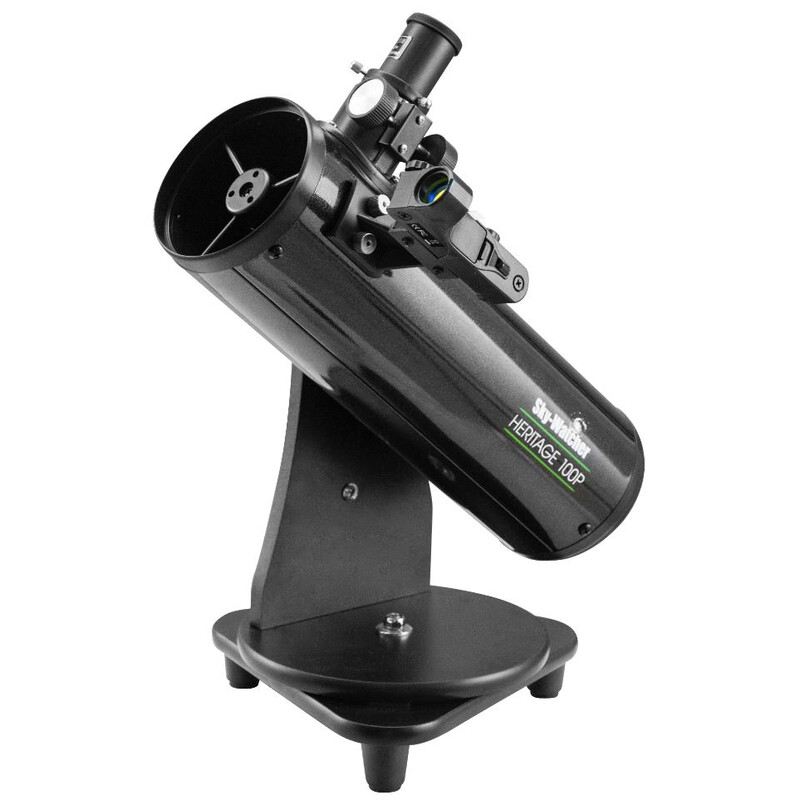
- Inexpensive and simple
- Extremely wide field of view
- Can also attach to a photo tripod
The Sky-Watcher Heritage 100P is a small telescope, but it still packs an impressive 4” (100mm) of aperture into a tiny package. This telescope easily fits in a small rucksack and features a parabolic primary mirror (though not subject to quite as rigorous quality control standards as higher-priced optics), with the 400mm focal length enabling a vast field of view with wide-angle 1.25” eyepieces. If you’re a beginner to the hobby, the pair of eyepieces and included Barlow lens are more than enough to get started.
While a tabletop telescope by design, the Heritage 100P features ¼ 20 threads at the bottom of its base to attach to a standard photo tripod. However, you’ll need a fairly robust tripod, which would likely cost more than the 100P itself does new.
1B) Cheapest Recommended Travel Telescope: Zhumell Z100
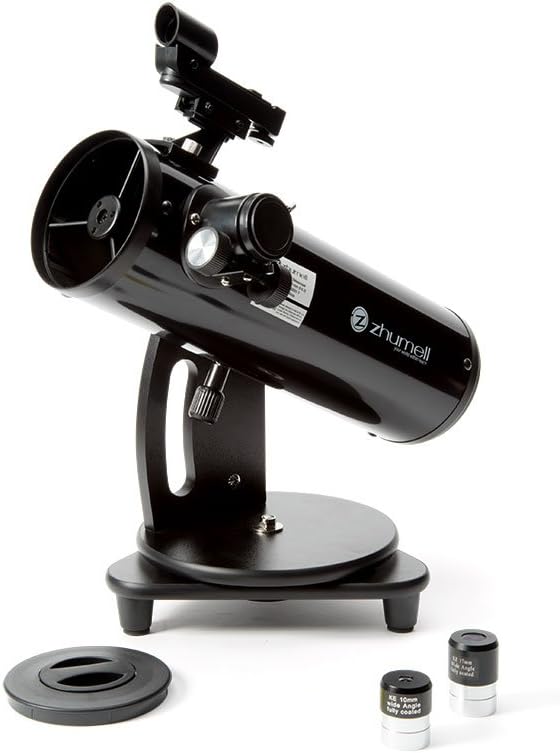
- Inexpensive and simple
- Extremely wide field of view
- Can also attach to a photo tripod
Like the Heritage 100P, the Zhumell Z100 is a 4” (100mm) f/4 tabletop Dobsonian, making the tube a mere 16” long and the entire scope weighing a mere 6.2 pounds (2.81 kg). It easily fits into a backpack or stows away in luggage, which makes it the best companion for traveling and camping.
2) Sky-Watcher Heritage 130P Tabletop Dobsonian
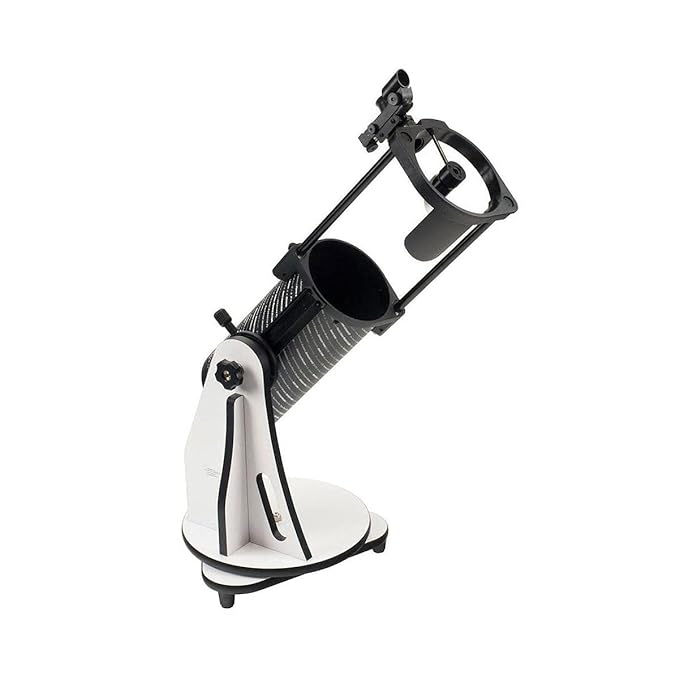
- Sharp views and great accessories
- A collapsible tube makes storage and transport easier
- Good value for the price
Sky-Watcher Heritage 130P is a 130mm f/5 tabletop Dobsonian with a special feature—its collapsible tube. The collapsible tube of the 130P shortens its length to a mere 14.5” (37 cm)—about half the length of a solid-tubed comparable instrument such as the Zhumell Z130. This makes the scope lighter and able to fit into a smaller space, such as a backpack, storage shelf, or carry case. This is also why our otherwise highly recommended Zhumell Z130 has been replaced by the Heritage 130P as our portable travel telescope pick.
The only downside is that you will need to make a removable shroud of some sort to wrap around the struts and shield the telescope’s optics from stray light, dew, or curious hands.
The optical quality is very good, and you can see a lot of stuff with a 130mm f/5 telescope like the Heritage 130P. 130mm of aperture means you get 30% brighter images than with a 114mm telescope, and 69% brighter than with a 100mm.
The Heritage 130P weighs only 14 lbs (6 kg)—only a bit more than the Zhumell Z114. It comes with two eyepieces (both 1.25”): a 25mm (26x) and a 10mm (65x), both of which are long-eye-relief designs based on the Konig optical layout. A collimation tool is included as well, as is a red dot finder to aim the telescope.
A fully computerized version of the Heritage 130P is available as the Sky-Watcher Virtuoso GTi 130P, which is identical apart from its motorized tracking.
£250-£325 Range
3A) Sky-Watcher Heritage 150P Tabletop Dobsonian
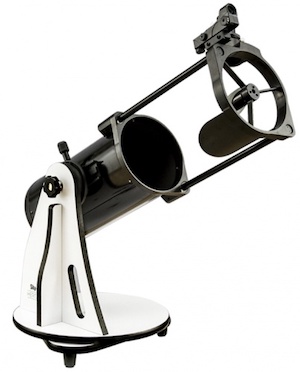
- Collapsible tube makes even airline travel feasible despite a 6” aperture
- Excellent value for the price
- Good balance of aperture and convenience, not just for travel
The Heritage 150P is one of the largest tabletop Dobsonians available, and it borrows extensively from the smaller Heritage 130P. The same collapsible tube keeps the scope fairly compact, though the width of the 150P’s base means it can be a bit more difficult to find a way to transport it on a plane, for instance. However, it’s still very portable and lightweight.
The longer 750mm focal length of the Heritage 150P and its fairly tall, sturdy base mean that you can get away with elevating the 150P on something like a milk crate or even a storage container as opposed to a table or stool, which simplifies finding somewhere to set it.
As with the Heritage 130P, a pair of 1.25” eyepieces (25mm and 10mm again, yielding 30x and 75x respectively), a collimation tool, and a red dot finder are included with the 150P, though you’ll want to invest in more eyepieces and construct some kind of shroud for the tube as soon as you can. A GoTo version of the Heritage 150P is also available as the Virtuoso GTi 150P Dobsonian, which is discussed below.
3B) Sky-Watcher Heritage 90P Virtuoso Mak
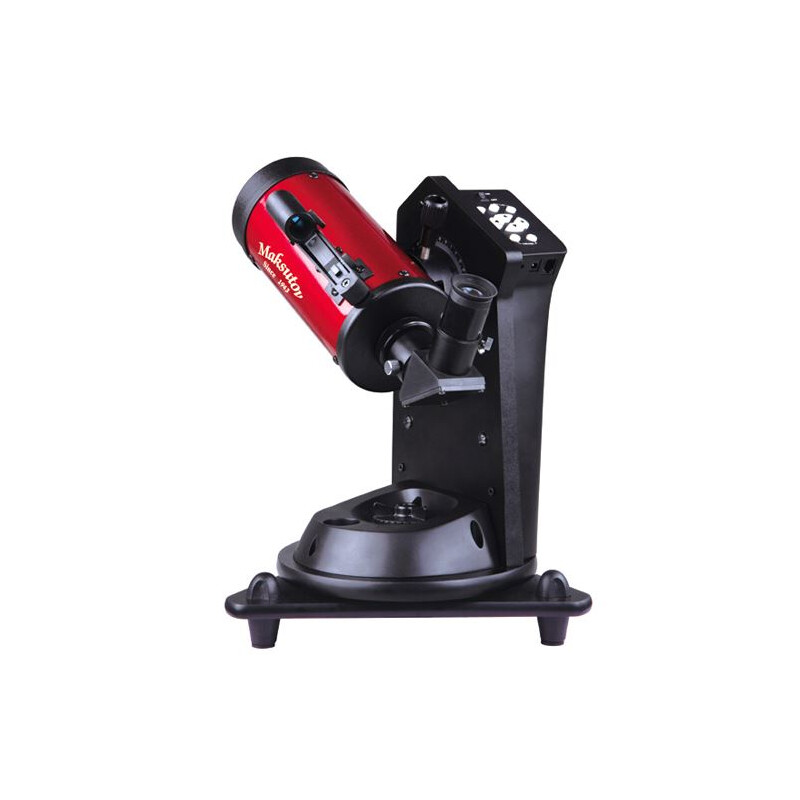
- Maksutov-Cassegrain optics provide great views of bright targets
- Included solar filter for viewing sunspots safely
- Motorized tracking without the hassle of aligning a GoTo mount makes for a quick and convenient setup
The Virtuoso has the same optical tube as many of the 90mm Maksutovs offered by Celestron, Sky-Watcher, and Orion, but on a nice auto-tracking tabletop mount (which can also be attached to a photo tripod). This mount isn’t capable of full GoTo without the addition of more hardware, but after being leveled and pointed north, it automatically tracks. A 90mm Maksutov with a 1250mm focal length like the Virtuoso 90 is hardly appropriate for deep-sky viewing anyway, and aiming the Virtuoso at the Moon and planets is hardly something that requires GoTo, so tracking alone is more than adequate.
The Virtuoso 90 provides splendid views of the Moon, planets, and other bright, small targets like double stars thanks to its high-quality Maksutov-Cassegrain optics, and there’s also a solar filter included which will allow you to safely and easily view sunspots. A pair of eyepieces—25mm and 10mm 1.25” units yielding 50x and 125x magnification—are included and are really all you need. A 5×24 finder is included for aiming the scope and isn’t exactly the highest quality, but it can be thankfully easily replaced.
The Virtuoso’s limited field of view and tiny aperture mean it’s only suitable for bright targets and simply won’t satisfy you on deep-sky objects. Thus, if your goal is to view, say, the southern sky from a tropical island, it probably isn’t a good choice (binoculars will be more exciting). However, for a portable telescope to bring to family, friends, or astronomy outreach events to get people excited about the rings of Saturn, the Virtuoso 90 is an excellent choice.
£325-£425 Range
4A) £325-425 – Sky-Watcher Virtuoso GTi 150P Tabletop Dobsonian
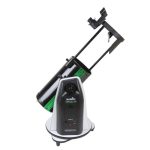
- Collapsible tube allows for airline travel and easy storage
- Fully motorized GoTo and tracking that can be used or switched off
- A great balance of aperture, convenience, and price
The Sky-Watcher Virtuoso GTi 150P uses the same optics, basic construction, and is provided with the same eyepieces and accessories as the standard Heritage 150P. The Virtuoso GTi, however, adds fully motorized tracking and aiming capabilities, either using Sky-Watcher’s free SynScan app or a more sophisticated astronomy app like SkySafari. You can also push the scope manually with the GoTo system activated without impairing the alignment thanks to Sky-Watcher’s FreedomFind technology; this is not found on many other GoTo telescope mounts. The same 25mm (30x) and 10mm (75x) 1.25” eyepieces are included with a collimation cap and red dot finder.
4B) £325-425 – Celestron Astro Fi 127
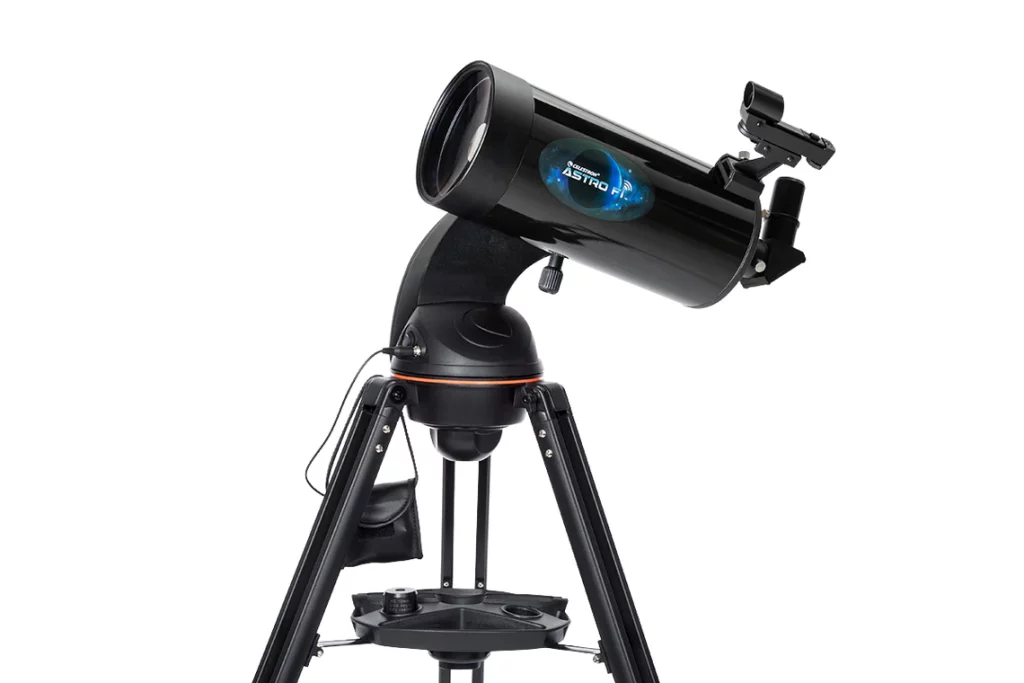
- 120mm Maksutov-Cassegrain optics give excellent lunar, planetary, double-star views
- Full-sized tripod and GoTo mounting
- WiFi-operated mount is easy to set up and use
A 120mm Maksutov-Cassegrain, the Astro Fi 127 comes equipped with a fully motorised GoTo mount. The integration of technology is seamless; one can effortlessly set up and control the telescope through their smartphone or tablet using Celestron’s free SkyPortal app. While you can’t aim the Astro Fi manually, it will automatically find and track any object from the SkyPortal app’s database (third party apps like SkySafari are also compatible). While not as capable as a 6” reflector like the Virtuoso/Heritage 150P, the Astro Fi 127 puts up excellent lunar, planetary, and double star views without the need for collimation.
£425-£550 Range
5A) £425-550 – Sky-Watcher 127 mm Skymax AZ-GTi Mak GoTo
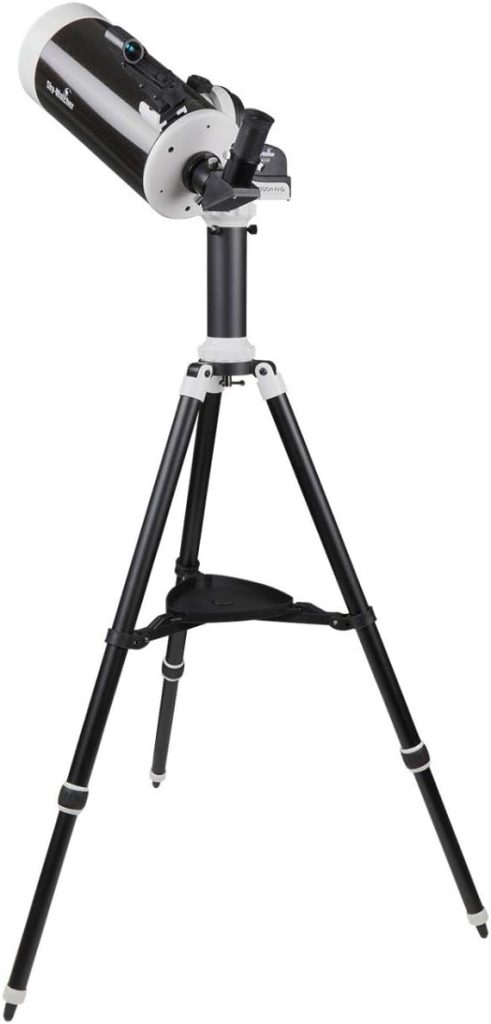
- 120mm Maksutov-Cassegrain optics provide nice views of Moon, planets, brighter deep-sky optics
- Manual or GoTo hybrid mount/tripod fits in luggage with OTA
- Lightweight, quick setup/assembly
While not actually a 127mm aperture (Sky-Watcher and Celestron’s “127mm” Maksutovs are really stopped down internally to about 120mm in aperture), the 127mm Skymax is a bit more capable than the 102mm Maksutov-Cassegrain models, and the AZ-GTi mount is packed with features. It’s a GoTo mount controlled with your phone or tablet, but as with Sky-Watcher’s other GTi mounts you can move the scope manually with the mount powered on or off, with no effect on the alignment of the computerized mount thanks to the advanced encoders. The GTi can be converted to an equatorial mount for deep-sky astrophotography too, albeit with a different optical tube attached. You control the GTi mount either with the free SynScan app or a paid but more capable astronomy app like SkySafari Pro.
The 127mm Skymax AZ-GTi includes a 1.25” prism star diagonal, a red dot finder, and two 1.25” “Super” eyepieces – a 25mm unit providing 60x magnification and a 10mm unit providing 150x; these are really the only eyepieces you’re likely to need with this telescope.
The 127mm Skymax AZ-GTi is ranked higher than the Celestron NexStar 5SE on our list here than our normal rankings pages as it’s not exactly the best beginner scope and has a narrower field of view. However, for portability purposes it beats the 5SE.
5B) £425-550 – Sky-Watcher 127 mm Skymax Virtuoso GTi Mak GoTo
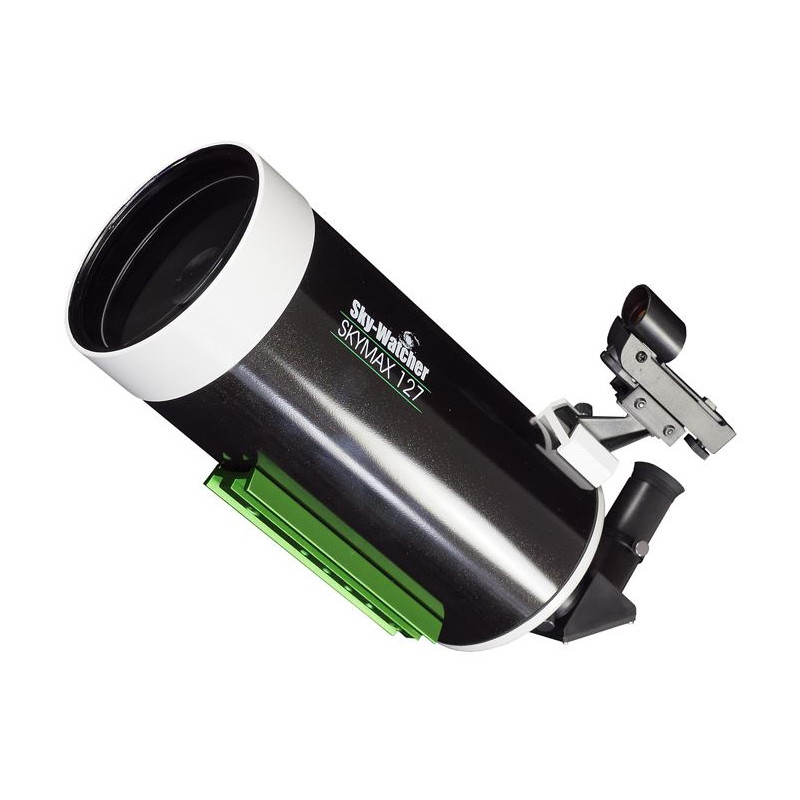
- Tabletop mount shares features of AZ-GTi but is more versatile, while still compatible with ⅜” tripod studs
- Sharp 120mm Maksutov-Cassegrain optics
- Extremely convenient to set up/use
The Virtuoso GTi/127mm SkyMax kit shares the optics, accessories, and design features of the SkyMax 127/AZ-GTi but utilises the tabletop Virtuoso GTi mount instead. Like the AZ-GTi, you get the benefits of WiFi-operated GoTo, the FreedomFind encoders, and automatic tracking once the mount is aligned on the sky. However, you’re able to use the Virtuoso GTi both as a tabletop mount or atop a compatible ⅜” tripod stud.
6) £550+ Range – Celestron NexStar 6SE
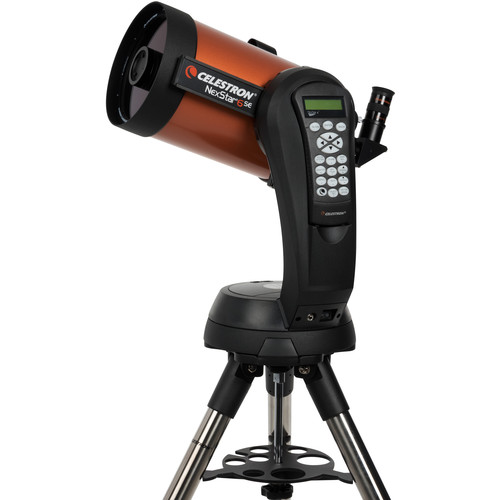
- 6” Schmidt-Cassegrain optics provide plenty of aperture for all targets
- Well-designed, sturdy GoTo mount and tripod
- Mount head/tube fits in carry-on luggage
The Celestron NexStar 6SE isn’t cheap, but it’s quite capable for viewing almost any target and can do astrophotography, too.
Unlike the smaller NexStar SE models and many of the other GoTo tripod-mounted instruments Celestron sells, the NexStar 6SE actually has enough aperture for the scope’s GoTo technology to be a useful utility rather than an inconvenient hindrance, and Celestron’s 6” SCTs seem to boast some of the best optics of their already high-quality SCTs, with StarBright XLT full multi-coatings and water-white corrector lens glass. The 6SE can accept many of the various SCT accessories that Celestron and Meade offer, including a 2” star diagonal, an f/6.3 focal reducer, a T-adapter, and more. You can also use the scope for deep-sky astrophotography with a focal reducer or Starizona HyperStar provided you switch the OTA onto an equatorial mount, and the stock mount works great for planetary or lunar astrophotography.
Being a Schmidt-Cassegrain, the 6SE is incredibly compact, with the optical tube only 16” long and weighing 10 pounds/4.53 kg. The entire telescope, with the tripod, weighs only 28.8 pounds/13 kg.
As for downsides? The NexStar 6SE comes with a single eyepiece – a 25mm Plossl giving 60x – so keep in mind that you’ll want some money left for more eyepieces. The scope also needs a dew shield, and the f/10 focal ratio means the field of view is rather limited compared to most Dobsonians of similar aperture. And such an expensive telescope can be a little scary to travel with due to the risk of theft or damage.
Celestron sells a carrying case for use with the 6SE, which we would highly recommend buying if you plan on flying with it, or you can put something together yourself out of any good pluck-foam case. The tripod can be checked in luggage, and the scope and mount can be carried on in their case.
Tips on Choosing & Using a Portable Travel Telescope
- Flying? Don’t Check Your Telescope!
Airline baggage handlers can drop your luggage more than ten feet onto conveyor belts and generally treat it roughly. This is obviously not good for a telescope with fragile glass optics. There is also the possibility of your telescope being stolen if it is recognisable, particularly if you’re travelling abroad to remote locations. Thus, you should try to bring as much of your telescope in a carry-on bag with you on the plane as possible—or at least the optical tube, which is the most expensive and most fragile part of your telescope. If you must check your travel telescope, find out if there are any insurance policies or special handling options for it.
- Aperture
If you’re taking your telescope to a dark site, you’ll probably want to spend most of your time observing deep-sky objects, which necessitates a larger aperture. However, don’t buy such a big telescope that you have to ship it ahead to your destination—or worse yet, in check in luggage.
- You Get What You Pay For
The more money you spend, the fewer fragile and inexpensive components your travel telescope will have. In a remote location without access to a hardware store or your backup accessories, this could mean the difference between using your telescope or not.
Flying with a telescope
Flying with a telescope is pretty much bound to be an infuriating, or at least stressful, process. Expect to get stopped in line at security. Always keep some sort of documentation with your telescope in case you’re questioned. We also don’t recommend checking your optical tube assembly in luggage, as it is very likely it will be dropped and smashed to pieces; mounts and tripods are more resilient and are usually safe in checked baggage, however.
One of the biggest considerations when flying with a telescope is exactly why you’re bothering with it in the first place. With the exception of expensive or homemade custom travel Dobsonians, the largest telescope you can fly with is probably no bigger than 6” in aperture. If you want good wide-field views of deep-sky objects in your travels to a dark location, big binoculars are less of a hassle, and if you’re going to be travelling to a place specifically for astronomy, it’s probably easier to just borrow a telescope from a friend, talk to a local astronomy club, or even rent one at your destination. You could even just buy a used telescope and give it away or sell it before you go home. If you’re not travelling specifically for astronomy purposes and just want to have a telescope, bear in mind that flying with it is going to be a pain and require some concessions as to what you bring.
